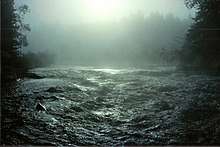Coulonge River
The Coulonge River (English: /kuːˈlɒndʒ/)[3] is a predominantly wilderness river in western Quebec, Canada.[4] One of a dozen or so significant tributaries of the Ottawa River, it has a length of 240 kilometres (150 mi)[1] and a drainage area of 5,060 square kilometres (1,950 sq mi),[2] and runs in a general south-eastern direction from its headwaters in Lac au Barrage (situated in La Vérendrye Wildlife Reserve) to the Ottawa River at Fort-Coulonge. Over that distance, it drops approximately 260 meters (850 ft) — 48 meters (157 ft) of that over the massive Grandes or Coulonge Chutes, approximately 15 kilometers (9.3 mi) upstream of the confluence with the Ottawa River.
| Coulonge River | |
|---|---|
Coulonge River near Pont Davidson | |
| Native name | Rivière Coulonge |
| Location | |
| Country | Canada |
| State | Quebec |
| Region | Outaouais |
| Physical characteristics | |
| Source | Lac au Barrage |
| • location | Lac-Pythonga, Quebec |
| • coordinates | 47°12′30″N 76°53′30″W |
| Mouth | Ottawa River |
• location | Fort-Coulonge, Quebec |
• coordinates | 45°51′44″N 76°45′54″W |
| Length | 240 km (150 mi)[1] |
| Basin size | 5,060 km2 (1,950 sq mi)[2] |
| Discharge | |
| • average | 75.35 m3/s (2,661 cu ft/s) |
| Basin features | |
| Tributaries | |
| • left | East Coulonge River |
A popular river for whitewater canoeing enthusiasts, it is often grouped together with the Dumoine and Noire Rivers as three of a kind. The three rivers share the same watershed, and have similar whitewater characteristics.[5] All three empty into the Ottawa River within a distance of 105 kilometers (65 mi) from one another.
The historic Félix-Gabriel-Marchand Bridge crosses the Coulonge River near Fort-Coulonge. Constructed in 1898, this 148.66 metres (487.7 ft) long bridge is the longest covered bridge in Quebec.[6][7]
History
The Coulonge River is named after Nicholas d'Ailleboust de Manthet (1663-1709), Sieur de Coulonge, a French explorer who spent the winter of 1694-95 at the nearby Allumettes Island.[1]

The Coulonge was used as a waterway by native North Americans and, later, by the coureurs des bois plying their independent trade in furs. In 1784, the North West Company built a fort at the mouth of the river, named Fort Coulonge, which passed into the hands of the Hudson's Bay Company when the 2 companies merged in 1821.[8]
In 1835, Scottish-born lumber baron George Bryson acquired timber rights to thousands of acres of forest in the area, including the 200 acres (81 ha) immediately surrounding the Grandes Chutes. In 1843, Bryson built a sawmill near the mouth of the river, which led to permanent settlement and the formation of the village of Fort-Coulonge.[8] To transport the squared timber safely past the falls and the 750 m (2,460 ft) gorge below, Bryson built a 915 m (3,002 ft)-long timber slide (a wooden chute flowing with water diverted from the head of the falls), which was replaced by a concrete chute in 1923.[9]
For almost 150 years, the forests around the Coulonge were logged throughout the winter months until spring breakup permitted the massive log drives which, along with similar operations throughout the Ottawa River watershed, fueled the economy of the Ottawa Valley region from the early 19th Century through the middle of the 20th.[5]
The last spring log drive in Canada took place on the Coulonge River in 1982.[10] Since then, the timber from smaller-scale logging operations has been hauled out by trucks over a network of dirt roads which meander throughout the Coulonge River valley.
In 1994, a hydro-electric dam and power station was built at the head of the Grandes Chutes, leaving the Dumoine River as the last major free-flowing tributary of the Ottawa River.
References
- Reference number 15496 of the Commission de toponymie du Québec (in French)
- Atlas of Canada. "Rivers in Canada". Archived from the original on 4 April 2007. Retrieved 2019-11-09.
- The Canadian Press (2017), The Canadian Press Stylebook (18th ed.), Toronto: The Canadian Press
- "Rivière Coulonge". Geographical Names Data Base. Natural Resources Canada. Retrieved 2019-11-07.
- Hap Wilson (1993). Rivers of the Upper Ottawa Valley - Myth, Magic & Adventure. Canadian Recreational Canoeing Association. ISBN 1-8954-6505-2.
- "Pont Félix-Gabriel-Marchand (Mansfield-et-Pontefract/Fort-Coulonge, 1898)". Structurae (in French). Retrieved 8 November 2019.
- Fletcher, Katharine; Fletcher, Eric (2010). Quebec Off the Beaten Path: A Guide to Unique Places (5th ed.). Morris Book Publishing LLC. ISBN 9780762765591. Retrieved 8 November 2019.
- Reference number 23187 of the Commission de toponymie du Québec (in French)
- "Les Chutes Coulonge – Voyage à travers le Québec". GrandQuebec.com (in French). Retrieved 8 November 2019.
- Oliver Anderson (5 July 2015). "Canoeing into Ottawa history". Ottawa Citizen. Retrieved 8 November 2019.
External links
![]()